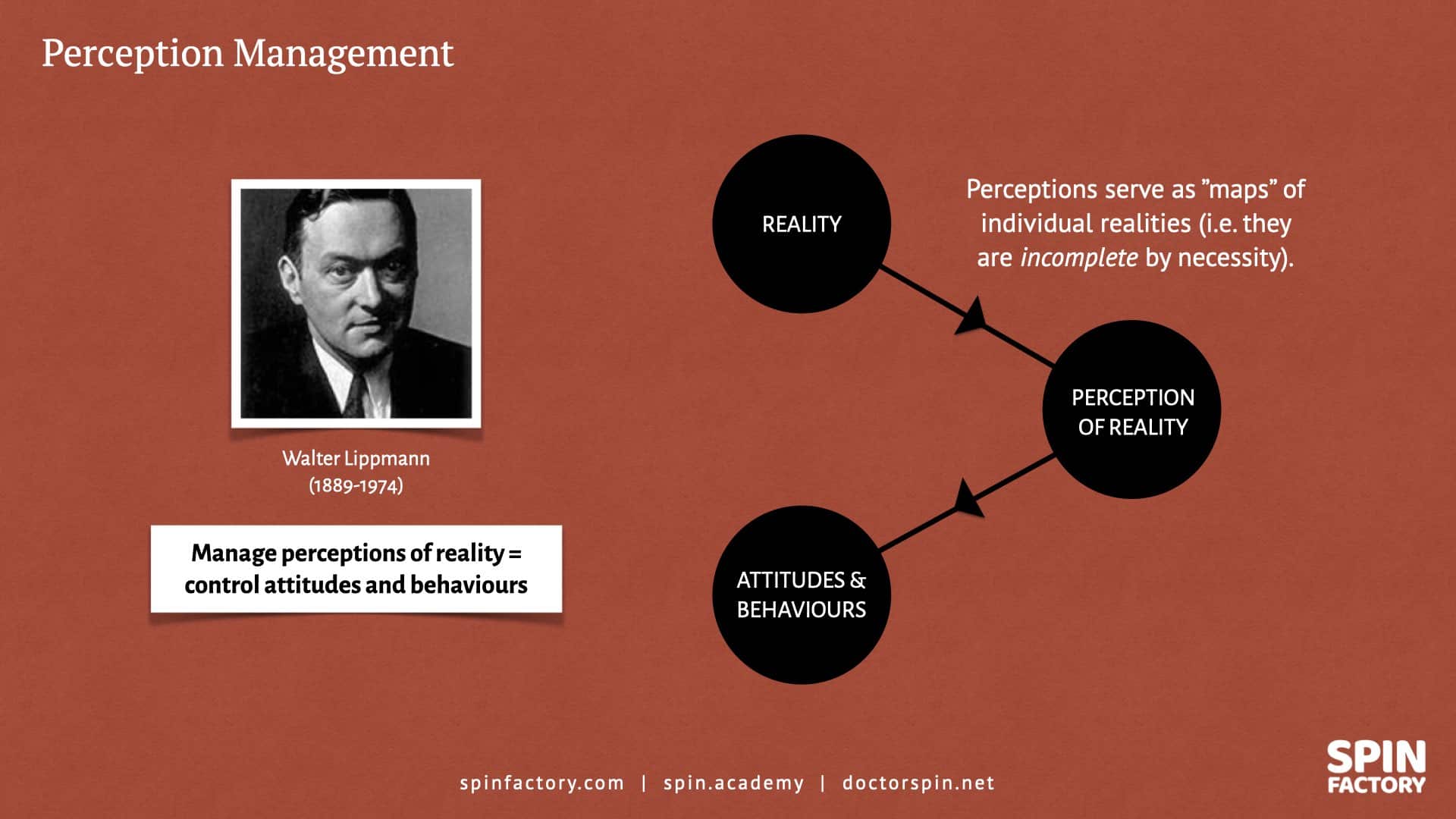Walter Lippmann’s ideas have heavily influenced PR.
Walter Lippmann, one of the most prominent American journalists and political commentators of the 20th century, left an indelible mark on media, public opinion, and democracy.
His intellectual legacy continues to shape our understanding of media’s role in society, the formation of public opinion, and the functioning of democratic institutions.
Here goes:
Managing Perceptions of Reality
Spin Academy | Online PR Courses
Walter Lippmann: Public Opinion and Perception Management
No one is basing their attitudes and behaviours on reality; we’re basing them on our perceptions of reality.
Walter Lippmann (1889 – 1974) proposed that our perceptions of reality differ from the actual reality. The reality is too vast and too complex for anyone to process. 1Lippmann, Walter. 1960. Public Opinion (1922). New York: Macmillan.
The research on perception management is focused on how organisations can create a desired reputation:
“The OPM [Organizational Perception Management] field focuses on the range of activities that help organisations establish and/or maintain a desired reputation (Staw et al., 1983). More specifically, OPM research has primarily focused on two interrelated factors: (1) the timing and goals of perception management activities and (2) specific perception management tactics (Elsbach, 2006).”
Source: Organization Development Journal 2Hargis, M. & Watt, John. (2010). Organizational perception management: A framework to overcome crisis events. Organization Development Journal. 28. 73 – 87. … Continue reading
Today, our perceptions are heavily influenced by news media and influencers, algorithms, and social graphs. Therefore, perception management is more critical than ever before.
“We are all captives of the picture in our head — our belief that the world we have experienced is the world that really exists.”
— Walter Lippmann (1889 – 1974)
Learn more: Walter Lippmann: Public Opinion and Perception Management
💡 Subscribe and get a free ebook on how to get better PR ideas.
Walter Lippmann and the Pseudo-Environment
Born in 1889 in New York City, Lippmann began his career in journalism at an early age, writing for various publications before eventually becoming a co-founder of The New Republic.
Over the course of his illustrious career, Lippmann penned numerous books, essays, and newspaper columns, grappling with some of the most pressing issues of his time.
Central to Lippmann’s work was his exploration of the relationship between media and democracy.
In his seminal book, “Public Opinion” (1922), Lippmann dissected the process through which news is disseminated and consumed, arguing that the media shapes public perception of reality by constructing a “pseudo-environment” that often distorts the truth. This idea, which highlighted journalism’s limitations and potential biases, underscored the importance of accurate reporting and the need for a well-informed citizenry in a functioning democracy.
The Manufacturing of Consent
Lippmann’s concept of the “manufacture of consent” further illustrated the power dynamics in the media landscape.
Lippmann argued that a small group of elites, whom he called the “invisible government,” wielded significant influence over public opinion by controlling the narrative presented in the media. This idea laid the groundwork for future theories on media manipulation and the role of propaganda in shaping public discourse.
At the same time, Lippmann was acutely aware of the challenges facing the average citizen in making sense of the complex world around them. He posited that individuals often rely on “stereotypes” or simplified mental constructs to process information and make decisions, which can lead to biases and misconceptions.
These “stereotypes” have profound implications for how media organizations present news and how individuals interpret it, emphasizing the need for critical thinking and media literacy in navigating the modern information landscape.
The Omnicompetent Citizen
Despite his scepticism about the ability of the general public to engage meaningfully with the complexities of contemporary issues, Lippmann remained a staunch advocate for democratic principles.
In his later work, “The Phantom Public” (1925), Lippmann grappled with the concept of the “omnicompetent citizen” and the role of public opinion in democratic governance. He contended that while the average citizen may not possess the expertise necessary to directly influence policy decisions, they still hold the power to keep decision-makers accountable through the ballot box.
Lippmann’s ideas on the role of journalism in democracy also extended to his advocacy for a responsible and ethical press. He was a key proponent of objective journalism, arguing that reporters should strive to provide unbiased, factual information to their audiences.
Media, Public Opinion, and Democracy
In conclusion, Walter Lippmann’s contributions to our understanding of media, public opinion, and democracy have left an enduring impact on the fields of journalism, political science, and communication studies.
His insights into the power dynamics in the media landscape, the limitations of public knowledge, and the responsibilities of the press in a democratic society remain as relevant today as they were during his lifetime.
In the constantly evolving media landscape, Walter Lippmann’s ideas on the interplay between media, public opinion, and democracy provide a valuable framework for understanding the challenges and responsibilities that both media organisations and individual citizens face.
By drawing on Lippmann’s insights, we can strive to create more informed, engaged, and critical publics capable of navigating the complexities of the modern information landscape and holding decision-makers accountable in pursuing a healthy, functioning democracy.

Thanks for reading. Please consider sharing my public relations blog with other communication and marketing professionals. If you have questions (or want to retain my PR services), please contact me at jerry@spinfactory.com.
Suggested Literature
Lippmann, W. (1922). Public opinion. Harcourt, Brace and Company.
Lippmann, W. (1925). The phantom public. Harcourt, Brace and Company.
Steel, R. (1980). Walter Lippmann and the American Century. Little, Brown and Company.
Schudson, M. (2008). Why democracies need an unlovable press. Polity.
McNair, B. (2011). An introduction to political communication (5th ed.). Routledge.
PR Resource: Notable PR Professionals
Spin Academy | Online PR Courses
Notable PR Contributors
It’s noted that the gender bias is apparent here. I’m currently researching a more balanced list.
💡 Subscribe and get a free ebook on how to get better PR ideas.
PR Resource: The Anatomy of Attention
“There’s only one thing in the world worse than being talked about, and that is not being talked about.”
— Oscar Wilde
Spin Academy | Online PR Courses
The Anatomy of Attention
Attention is an essential component of public relations:
And it’s not just organisations. We all seem to crave attention in some form or another:
“People want to be loved; failing that admired; failing that feared; failing that hated and despised. They want to evoke some sort of sentiment. The soul shudders before oblivion and seeks connection at any price.”
— Hjalmar Söderberg (1869−1941), Swedish author
It’s fear of social isolation— and attention starvation.
But what constitutes ‘attention’?
“Attention is a complex, real neural architecture (‘RNA’) model that integrates various cognitive models and brain centers to perform tasks like visual search.”
Source: Trends in cognitive sciences 3Shipp, S. (2004). The brain circuitry of attention. Trends in Cognitive Sciences, 8, 223 – 230. https://doi.org/10.1016/j.tics.2004.03.004
Each of the below terms refers to a specific aspect or type of attention (“mental bandwidth”), a complex cognitive process. 4Schweizer, K., Moosbrugger, H., & Goldhammer, F. (2005). The structure of the relationship between attention and intelligence. Intelligence, 33(6), 589 – 611. … Continue reading
Let’s explore different types of attention:
Each type of attention plays a crucial role in how we interact with and process information from our environment, and understanding these different aspects is key in fields like psychology, neuroscience, and education.
Learn more: The Anatomy of Attention
💡 Subscribe and get a free ebook on how to get better PR ideas.
“There’s only one thing in the world worse than being talked about, and that is not being talked about.”
— Oscar Wilde
Spin Academy | Online PR Courses
The Anatomy of Attention
Attention is an essential component of public relations:
And it’s not just organisations. We all seem to crave attention in some form or another:
“People want to be loved; failing that admired; failing that feared; failing that hated and despised. They want to evoke some sort of sentiment. The soul shudders before oblivion and seeks connection at any price.”
— Hjalmar Söderberg (1869−1941), Swedish author
It’s fear of social isolation— and attention starvation.
But what constitutes ‘attention’?
“Attention is a complex, real neural architecture (‘RNA’) model that integrates various cognitive models and brain centers to perform tasks like visual search.”
Source: Trends in cognitive sciences 5Shipp, S. (2004). The brain circuitry of attention. Trends in Cognitive Sciences, 8, 223 – 230. https://doi.org/10.1016/j.tics.2004.03.004
Each of the below terms refers to a specific aspect or type of attention (“mental bandwidth”), a complex cognitive process. 6Schweizer, K., Moosbrugger, H., & Goldhammer, F. (2005). The structure of the relationship between attention and intelligence. Intelligence, 33(6), 589 – 611. … Continue reading
Let’s explore different types of attention:
Each type of attention plays a crucial role in how we interact with and process information from our environment, and understanding these different aspects is key in fields like psychology, neuroscience, and education.
Learn more: The Anatomy of Attention
💡 Subscribe and get a free ebook on how to get better PR ideas.
ANNOTATIONS
| 1 | Lippmann, Walter. 1960. Public Opinion (1922). New York: Macmillan. |
|---|---|
| 2 | Hargis, M. & Watt, John. (2010). Organizational perception management: A framework to overcome crisis events. Organization Development Journal. 28. 73 – 87. https://www.researchgate.net/publication/288292596_Organizational_perception_management_A_framework_to_overcome_crisis_events |
| 3, 5 | Shipp, S. (2004). The brain circuitry of attention. Trends in Cognitive Sciences, 8, 223 – 230. https://doi.org/10.1016/j.tics.2004.03.004 |
| 4, 6 | Schweizer, K., Moosbrugger, H., & Goldhammer, F. (2005). The structure of the relationship between attention and intelligence. Intelligence, 33(6), 589 – 611. https://doi.org/10.1016/j.intell.2005.07.001 |

























